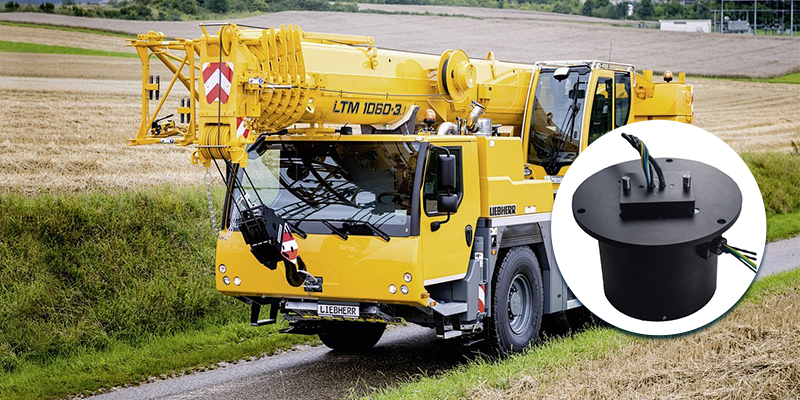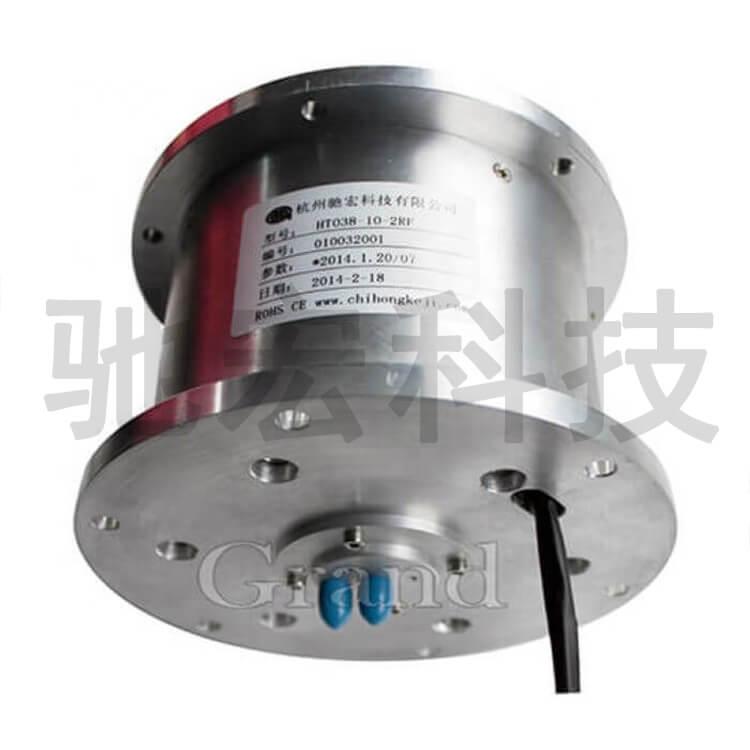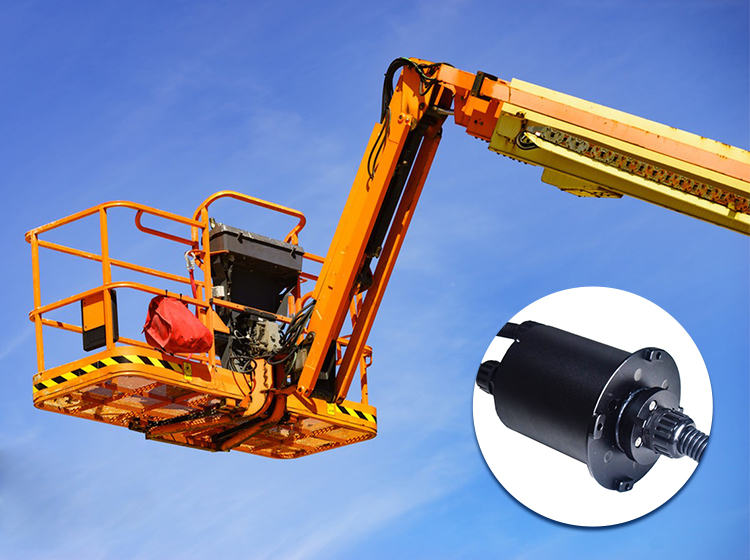From enhancing performance to keeping up with incoming technical advancements, this comprehensive article aims to explore and address primary aspects and user concerns associated with the slip ring application in aerial work vehicles.
Introduction to Slip Ring Application in Aerial Work Vehicles
Aerial work vehicles (AWVs) play a critical role in multiple industries, particularly involving work in high-elevation areas or places difficult to reach by other means. These vehicles include boom lifts, scissor lifts, cherry pickers, and telehandlers, which are extensively used in the construction, telecommunication, tree care, and maintenance industries. They help professionals manage tasks at significant heights efficiently, safely, and accurately.
In such vehicles, slip rings serve as a crucial component that not only enhances the overall performance but also ensures smooth, uninterrupted operation. AWVs often comprise a rotating platform that requires continuous electrical connections to function. Slip rings establish electrical connections between a stationary part and a rotating one, thus enabling the provision of power and transmitting signals while the platform is in motion, without causing damage to the cables.
In this article, we delve into the benefits of using slip rings, the concerns users often come across while applying slip rings in AWVs, and the solutions to these concerns. As we move further, we also analyze real-life case studies and the latest technological advancements in slip rings to provide a well-rounded view of their application in aerial work vehicles.

Understanding Slip Rings and Their Functionality in AWVs
When encountering the term for the first time, one might ask, “What are slip rings?” Slip rings, also known as rotary electrical interfaces or electrical rotary joints, are electromechanical devices. They are designed to transmit electrical power and signals from a stationary system to a rotating system. They play a vital role in systems where constant rotation is required without obstructing the flow of electrical connections.

In the context of aerial work vehicles (AWVs), slip rings act as the backbone for their functionality. These vehicles often possess a rotating part, such as a platform, boom, or bucket arm. As these components rotate, there’s a requirement for persistent power and signal transmission for the control and monitoring systems. This is where slip rings come into play.
Slip rings in AWVs serve to bridge a stable electrical connection between the stationary and rotating parts, making continuous power supply and signal transmission possible, even during movement. They help avoid any obstruction in operation due to twisted or entangled cables from rotation, ensuring that the AWV can operate at its peak efficiency.
Another indispensable function of slip rings is their role in AWVs’ safety systems. Certain safety measures, such as alarms, flashing light systems, and security camera feeds, depend on the unhindered transmission of signals facilitated by slip rings.
Overall, slip rings are critical to the effective, productive, and safe operation of aerial work vehicles, making them an integral component of these systems.
Benefits of Using Slip Rings in AWVs
Slip rings’ core functionality has a far-reaching impact on the overall operation of aerial work vehicles (AWVs), bringing several tangible benefits.
To begin with, one significant advantage of slip rings is enhanced performance. The incorporation of slip rings in AWVs ensures smooth and stable power supply and signal transmission even during the rotating platform’s movement. This uninterrupted flow of power aids the AWVs in operating at enhanced working efficiency, enhancing their performance remarkably.
Slip rings also contribute to improved equipment durability. The traditional wiring or cable systems are often subjected to damage from the continuous twisting and coiling caused by the rotation. However, with slip rings in place, these issues are mitigated to a significant extent. By preventing cable damage, slip rings increase the lifespan of their moving parts, ultimately improving the overall durability of the AWVs.
An increase in data transmission capabilities is another boon from using slip rings in AWVs. Slip rings can simultaneously transmit multiple signals without interference. This is particularly helpful in modern AWVs where data from various sensors and monitoring systems is collected and processed to provide valuable insights for operation optimization and issue detection.
Lastly, a chief concern for any industrial operation is downtime. Reduced downtime is a direct result of the improved durability and redundancy in power and data transmission that slip rings offer. Unplanned system shutdowns due to cable damages are minimized, thereby ensuring an AWV’s continuous operation.
In summary, incorporating slip rings in AWVs enhances the performance, extends the lifespan of equipment, increases data transmission capabilities, and leads to minimized downtime, making them an indispensable addition to these vehicles.
User Concerns with Slip Ring Application in AWVs
As beneficial as they are, the application of slip rings in aerial work vehicles (AWVs) isn’t without its challenges, often leading to user concerns in various aspects.
Firstly, the cost implications of integrating slip rings can be a point of concern for many users. The initial investment includes both the purchase of the slip rings and the cost of integration into the AWVs. Naturally, such expenses come under scrutiny, especially among users seeking cost-effective short-term solutions.
Secondly, durability is a vital issue. AWVs typically operate under demanding conditions — exposed to harsh weather, dust, moisture, and continual wear from constant rotation. Users often express concerns about the durability of slip rings under these harsh operating conditions, and whether they can deliver consistent performance over an extended period.
Furthermore, the applicability and integration of slip rings into existing AWV systems often pose challenges. Compatibility with the existing equipment, ease of installation, and minimal disruption during the integration process are all important considerations. Users may express worries about the technical complexity of integrating slip rings into their AWVs and the potential disruption of operations during this phase.
Finally, the training needed for the maintenance and operation of the slip rings is another area of concern. Since slip rings are electromechanical components with specific operating conditions and maintenance protocols, users will need training to ensure correct installation, operation, and upkeep. This requirement may raise concerns about the time and resources needed for the effective training of their staff.
Acknowledging these concerns is a vital step in making the integration of slip rings in AWVs more user-friendly and efficient, ensuring optimal results from this advantageous inclusion.
Slip Ring Application in Aerial Work Vehicles: Mitigating User Concerns
Addressing user concerns surrounding the application of slip rings in aerial work vehicles (AWVs) is essential for a successful integration process. By understanding potential challenges and identifying effective solutions, users can maximize the benefits of slip rings while minimizing potential issues.
For starters, conducting a cost-benefit analysis of slip ring integration will give users a clearer picture of the long-term advantages. Though the initial investment may seem formidable, the enhanced performance, reduced downtime, and extended equipment lifespan provided by slip rings often offset these costs. By quantifying the benefits, users can make informed decisions about adopting slip rings and be better equipped to justify the initial expenses based on long-term operational improvements.
In terms of durability and applicability, selecting the right slip ring type tailored to specific AWV demands is paramount. Manufacturers offer various slip rings with distinct specifications, materials, and capabilities to cater to different operating environments and requirements. Users should assess factors like weather resistance, material durability, and the anticipated range of motion when choosing slip rings for their AWVs.
Partnering with reputable manufacturers is also crucial. These manufacturers have the expertise and resources to guide users in selecting the most suitable slip rings for their AWV applications and can provide effective support during the installation process. They ensure that the slip rings are manufactured and tested to the highest standards, offering greater reliability and resilience in demanding conditions.
Lastly, the process of training and support shouldn’t be overlooked. The staff needs to have access to appropriate training resources for the correct maintenance and operation of slip rings. Manufacturers often provide comprehensive guides, video tutorials, and expert technical support. Taking advantage of these resources or even sending staff for in-person training opportunities can ensure that AWV operators can properly manage and maintain slip ring-equipped vehicles.
By focusing on these aspects – conducting a cost-benefit analysis, choosing suitable slip ring types, collaborating with reputable manufacturers, and utilizing available training resources – AWV users can mitigate common concerns and effectively embrace the advantages brought about by the integration of slip rings in their systems.
Slip Ring Application in Aerial Work Vehicles: Real-Life Examples/Case Studies
Real-life examples offer valuable insights into the application of slip rings in aerial work vehicles (AWVs) and their positive impact on operations. In this section, we explore a few case studies in which slip rings have been implemented successfully, showcasing the benefits they bring to AWVs.
Case Study 1: Utility Company Uses Slip Rings for Improved Bucket Truck Operations
A utility company operating in the Southeast region of the United States required a solution to overcome electrical connection issues affecting their bucket trucks. These trucks are deployed for power line maintenance, necessitating stable electrical connections even during platform rotations. They encountered frequent cable damage due to twists and tangles, leading to reduced equipment durability and increased downtime.
By incorporating slip rings into their bucket truck designs, the utility company was able to solve these challenges. The slip rings facilitated continuous power and signal transmission without cable damage, improving the trucks’ operational performance. The equipment also displayed increased durability and a significant decrease in downtime. Consequently, the company observed a substantial increase in overall efficiency and cost savings.
Case Study 2: Telecommunication Company Achieves Improved Maintenance Efficiency Through Slip Rings
A telecommunication company from Europe was experiencing difficulties maintaining and upgrading its communication towers due to the limitations of its existing aerial work platforms. The platforms struggled to maintain stable power and signal connections while rotating, which negatively impacted the efficiency of their maintenance operations.
By integrating slip rings into their aerial work platforms, the company experienced a marked improvement in maintenance efficiency. The improved electrical connections allowed the work platforms to rotate freely without causing disruptions. The added stability in the transmission of signals, as well as the uninterrupted power supply, had a significant impact on the productivity of technicians working on the communication towers.
Case Study 3: Construction Company Streamlines Multi-story Building Construction with Slip Rings
A midwestern US construction company was facing challenges during multi-story building construction projects. The boom lifts used for access at higher elevations were experiencing frequent cable damage due to continuous rotation, reducing their operational efficiency.
By adopting slip rings in their boom lifts, the construction company overcame the cable damage problem. The slip rings enabled smooth power and signal transmission during rotation, allowing the boom lifts to operate seamlessly. The reduced downtime, combined with the equipment’s enhanced durability and performance, led to substantial time and cost savings during the construction of multi-story buildings.
These case studies elucidate the instrumental role slip rings play in the successful operation of AWVs across various industries. By addressing specific challenges and streamlining operations, slip rings contribute to improved outcomes for companies that adopt them in their aerial work vehicles.
Future Trends and Innovations in Slip Rings for AWVs
The ever-evolving technological advancements are shaping the future trends and innovations in slip rings for aerial work vehicles (AWVs). Manufacturers are continuously working on upgrades and innovations to better serve their users and improve AWVs’ operational efficiency.
Smart Slip Rings with Real-Time Monitoring and Predictive Maintenance
One of the most exciting trends on the horizon is the integration of smart technology with slip rings. These intelligent devices, often incorporating Internet of Things (IoT) technology, allow for real-time performance monitoring and enhanced predictive maintenance. By capturing vital data such as temperature, vibration, wear, and tear, smart slip rings could predict possible faults or downtime, enabling preventive measures to improve AWV operations’ reliability and lifespan.
Enhanced Data Transmission Capabilities
As AWVs are becoming more sophisticated, there is a mounting need for enhanced data transmission capabilities in slip rings. Future slip rings are likely to handle larger data volumes and higher speeds, catering to the increased data generated by the various sensors and processing units in AWVs. Such upgraded slip rings will play a crucial part in the efficient functioning and intercommunication of different components, improving data flows, and overall operational efficiency.
Use of Advanced Materials for Increased Durability
Advancements in material science are likely to influence the construction of future slip rings. With the use of advanced materials, like improved alloys or specialized composites, companies can enhance the durability and resilience of slip rings under extreme operating conditions. The possibility of self-lubricating materials could also further mitigate the wear and tear of the rotating parts, consequently extending their lifespan.
Energy-Efficient Designs for Sustainability
With the growing global focus on sustainability and energy efficiency, slip rings are no exception. Energy-efficient designs aim to reduce power consumption, extend product life, and minimize environmental impact. Future slip rings are expected to incorporate these green design philosophies, contributing to more sustainable operations for AWVs and aligning with environmental objectives.
These emerging trends in slip rings will further improve their applicability, performance, and durability in AWVs. With these innovations, they will continue to play an increasingly important role in the smooth and efficient operation of AWVs around the world.
Conclusion
Gaining an appropriate understanding and addressing user concerns can ensure successful slip ring integration in AWVs. Embracing slip ring technology presents a way to elevate AWV performance, extend operational life, and maintain pace with evolving technological trends.
FAQs about Slip Ring Application in Aerial Work Vehicles
The application of slip rings in aerial work vehicles (AWVs) often brings up specific questions for those unfamiliar with the system’s intricacies. Here are some frequently asked questions, along with their respective responses, about slip rings in AWVs.
Q1: What role do slip rings play in AWVs?
A: Slip rings in AWVs allow for the unrestricted, continuous transmission of electrical power and signals between the fixed and rotating parts of the vehicle, such as between the operating cabin and the elevated platform or bucket. This capability prevents cable twisting, reducing wear and tear and equipment downtime.
Q2: How does the use of slip rings impact the operational efficiency of AWVs?
A: By enabling seamless power and signal transmission irrespective of the rotational motion, slip rings significantly enhance operational efficiency. They help prevent cable damage due to twisting, thereby decreasing the need for cable replacements or repairs and reducing downtime.
Q3: What factors should be considered when selecting slip rings for AWVs?
A: Factors to consider when selecting slip rings include the slip ring’s load capacity (determined by voltage and current requirements), environmental resistance (ability to work in the specific operating conditions of the AWVs), required speed of rotation, and durability.
Q4: Are slip rings difficult to maintain?
A: While slip rings do require maintenance, most modern designs are engineered to be low-maintenance. Many manufacturers offer comprehensive guides and support for maintaining their products. With proper care and regular checks, slip rings can offer robust and reliable service for a long period.
Q5: Can existing AWVs be retrofitted with slip rings?
A: Yes, many existing AWVs can be retrofitted with slip rings. However, the exact feasibility depends on the specific make and model of the vehicle. It’s best to consult with a slip ring manufacturer or a knowledgeable AWV professional to assess retrofitting’s viability in each case.
See What We Can Do

